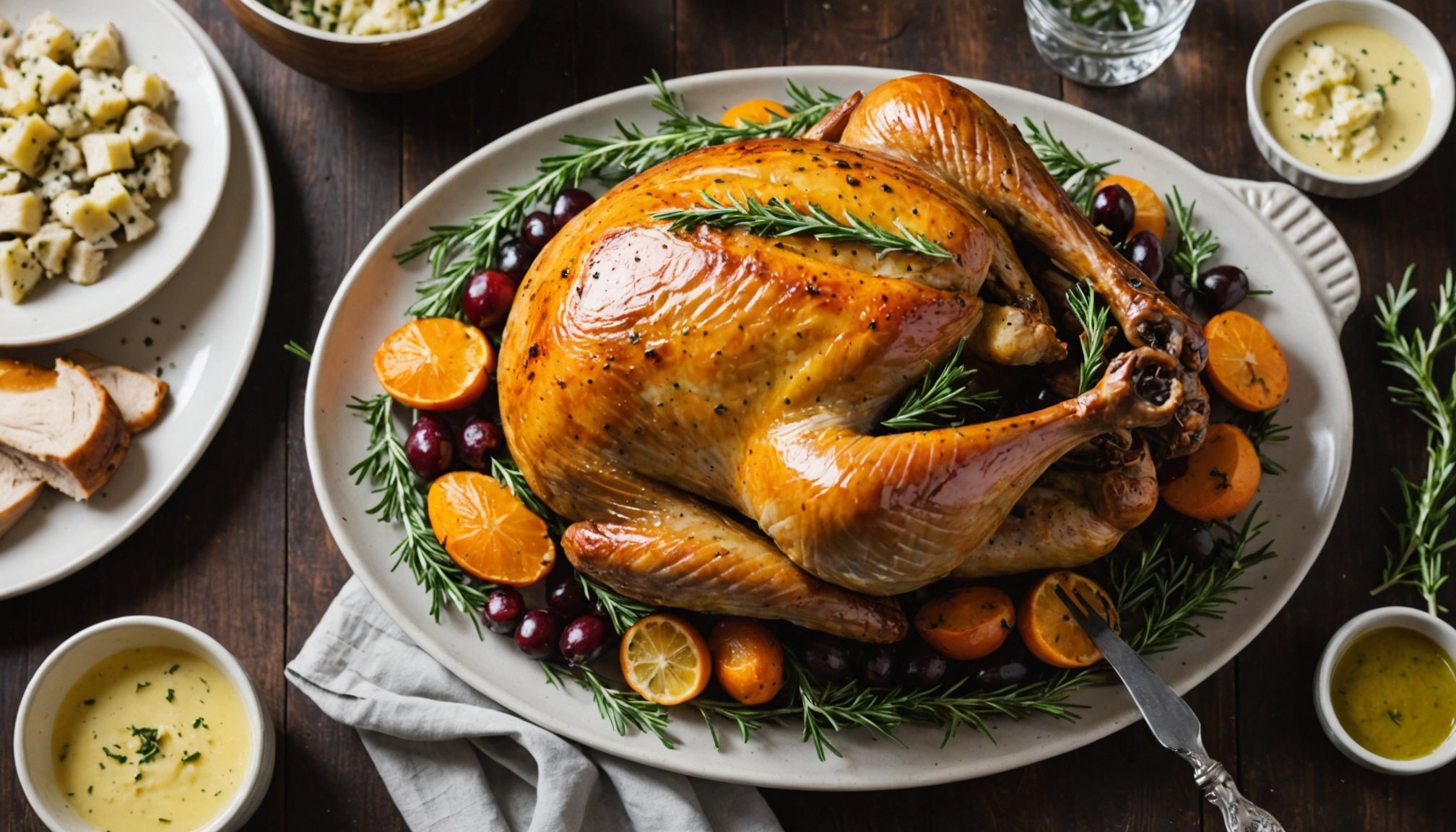Understanding Roast Turkey Techniques
Creating the perfect roast turkey requires mastering several cooking methods and careful turkey preparation. One of the initial steps that dramatically enhance flavour and moisture is brining. Brining involves soaking the turkey in a solution of water, salt, and sometimes additional herbs or spices. This preparation method ensures the turkey remains juicy and flavourful throughout the roasting process.
Different roasting techniques can be used depending on the desired results. Classic roasting in an oven is the most traditional approach, allowing for a crispy skin and tender meat. Spatchcocking, where the turkey is butterflied, can also provide an evenly cooked bird with less roasting time. Additionally, slow-roasting gives the turkey a distinct, rich flavour, albeit requiring a longer cook time.
Additional reading : Unlocking the Secret to Light and Fluffy English Pancakes: Your Ultimate Guide!
Seasoning the bird is critical. A well-seasoned turkey has layers of flavour that complement its natural taste. Suggested cooking methods for optimal results include covering the turkey with foil for a portion of the cooking time to prevent the skin from over-browning while ensuring the internal meat cooks thoroughly. By understanding and utilising these techniques, any home cook can serve a roast turkey that’s both delicious and memorable.
Crafting Herb Butter for Flavor Enhancement
Creating herb butter at home is a simple yet effective way to enhance the taste of your culinary creations. The right flavoring techniques can elevate everyday meals to gourmet experiences.
Also read : Unlocking the Secrets to a Delightfully Creamy and Zesty Lemon Posset: Tips and Tricks!
Essential Ingredients for Herb Butter
To craft the perfect herb butter, begin with high-quality unsalted butter. This acts as the ideal base since it allows the natural flavors of your herbs and spices to shine. Common herbs include parsley, chives, and thyme, but the possibilities are endless. You might also incorporate garlic or lemon zest for an extra burst of flavor. Remember, the freshness of your ingredients significantly impacts the final taste.
How to Make Herb Butter
Start by softening your butter to room temperature. Mix in your chosen herbs and seasonings until well combined. Once blended, place the mixture on parchment paper and roll it into a log. Chill in the refrigerator until firm. This basic seasoning preparation ensures your herb butter is ready to slice and use whenever needed.
Infusion Techniques for Maximum Flavor
Achieving maximum flavor requires thoughtful infusion techniques. Allow your herb butter mixture to sit for a few hours before chilling; this helps the flavors meld together. Consider experimenting with different combinations of herbs and spices to find your preferred taste profile. Proper storage in an airtight container will keep your herb butter fresh and ready to enhance any dish.
Step-by-Step Roast Turkey Recipe
Embarking on a journey to prepare the perfect roast turkey requires attention to detail, particularly when considering the ingredient list and cooking times. Here’s a cooking guide that will help you master this quintessential dish for your holiday cooking.
Start with these essential ingredients:
- A 5-6kg turkey, preferably defrosted if previously frozen
- 100g of unsalted butter, softened
- 3 cloves of garlic, minced
- Fresh herbs such as rosemary, thyme, and sage
- Salt and freshly ground black pepper
- Lemon and onion, quartered
Roasting Instructions for Perfect Cooking
- Preheat your oven to 180°C (350°F).
- Pat the turkey dry with paper towels, then season generously with salt and pepper.
- Gently loosen the skin from the turkey breast and spread the butter-garlic mixture underneath.
- Stuff the cavity with lemon, onion, and herbs for additional flavour.
- Roast the bird uncovered, aiming for an internal temperature of 74°C (165°F) in the thickest part of the thigh (approximately 3 to 3.5 hours for a 5-6kg turkey).
By following this roast turkey recipe with precision, you’ll ensure even cooking and delight your guests with a succulent main course.
Serving Suggestions and Side Dishes
When creating a memorable holiday experience, pairing the main dish with the right accompaniments can elevate the meal.
Complementary Side Dishes for Roast Turkey
Roast turkey shines best when served with side dishes that complement its flavours. Consider classics like mashed potatoes, which offer a creamy contrast to turkey’s robust nature. Cranberry sauce also pairs well, providing a sweet and tart balance. For added texture, consider roasted vegetables like carrots and Brussels sprouts, which add colour and depth. Stuffing and gravy are traditional companions that bring harmony to the meal.
Presentation Tips for a Stunning Holiday Table
A captivating presentation can further enhance your dining experience. Use broad platters for turkey to give it a centre-stage presence. Decorate the table with fresh herbs and seasonal centrepieces such as small pumpkins or autumn leaves. Coordinating napkins and plates in rich colours, like burgundy or gold, can accentuate the holiday theme and make your table inviting.
Pairing Wine with Roast Turkey
Selecting the right wine can truly elevate your roast turkey meal. Light-bodied reds like Pinot Noir or white wines such as Chardonnay complement turkey’s flavours well. They provide a refreshing contrast and balance to the richness of the dish. Opt for wines with fruity notes to accentuate the turkey’s natural flavours.
Common Pitfalls and Troubleshooting
Roasting a turkey isn’t always straightforward, and common mistakes can lead to less-than-ideal results. Recognising these pitfalls is the first step toward culinary success.
One of the most frequent errors is overcooking. This results from assuming a turkey is fully cooked when it reaches the right colour on the outside. Instead, use a thermometer to check the internal temperature, ensuring it reaches at least 74°C (165°F) in the thickest part of the breast. In contrast, undercooking usually occurs when precise time isn’t considered. Calculate overall cooking time based on weight, and again, rely on a thermometer for accuracy.
Retaining moisture is another challenge. To combat dryness, consider basting the turkey regularly or using a brine prior to roasting. A cooking pitfall many face is neglecting these moisture retention techniques, which are crucial for a juicy outcome. It’s not just about cooking time but the method too.
Troubleshooting tips such as adjusting oven racks and wrapping the turkey in foil can help manage roasting inconsistencies. Each turkey is unique, and slight adjustments to these techniques may be necessary to perfect your own traditional holiday roast.
User Reviews and Testimonials
Exploring real-life user experiences with herb butter turkey sheds light on the joys and challenges of creating this delicious dish. The feedback gathered offers valuable insights into both successful endeavours and creative adaptations that have emerged from various kitchens.
Highlighting User Success Stories
Many users shared their culinary victories, noting the succulent texture and rich flavours achieved with herb butter turkey. Enthusiasts raved about how their gatherings were elevated by this dish, receiving compliments that reaffirmed their efforts. These success stories underscore the appeal and feasibility of the recipe.
Incorporating Tips from Cooking Experiences
Readers eagerly contributed cooking feedback, suggesting nuances that enhanced their outcomes. A common tip was to adequately infuse the butter with herbs beforehand for a more pronounced taste. Others recommended adjusting the cooking time based on turkey size to ensure juiciness. Such advice has aided countless home chefs in refining their technique.
Feedback on Herb Butter Flavors
The diverse flavor profiles highlighted in reviews showcased the myriad ways cooks tailored the dish to personal tastes. Variations like adding extra garlic or experimenting with different herb combinations were frequently praised. This openness to customization has made the dish a favourite among those looking for a signature holiday aroma.
Alternative Cooking Methods for Roast Turkey
Diving into alternative cooking methods can transform traditional turkey recipes into unique culinary experiences. Smoking the turkey infuses it with rich, smoky flavors, distinguishing it from conventional roasting. This method requires a smoker and patience, as the low, slow heat ensures a tender and juicy result.
Alternatively, frying the turkey offers a crispy, golden-brown exterior while sealing in the interior’s moisture. This method is quicker than roasting or smoking but requires careful attention to safety due to the use of hot oil.
For those with a more relaxed timeline, slow cooking provides a way to achieve incredibly tender meat, allowing the turkey to cook in its own juices. Using a sous vide technique takes this a step further by cooking the turkey evenly throughout at a precise temperature. This method retains moisture and enhances the bird’s natural flavors.
Each method has its own benefits and influences both the flavor and texture of the turkey. While smoking adds depth, frying creates contrast between crispy skin and juicy meat, and slow cooking ensures a deep richness. Choosing an alternative method should consider the desired outcome and equipment available, making turkey preparation a personalised process.











